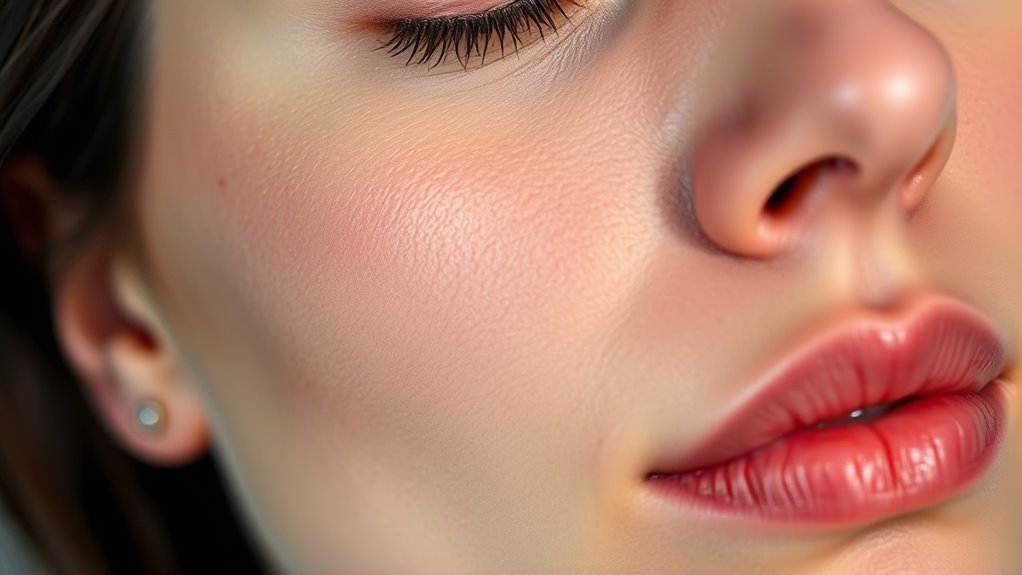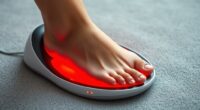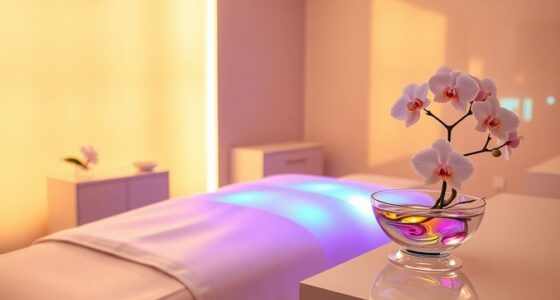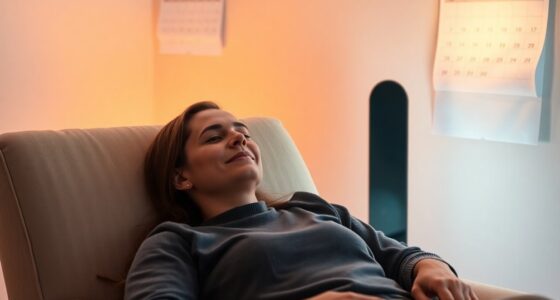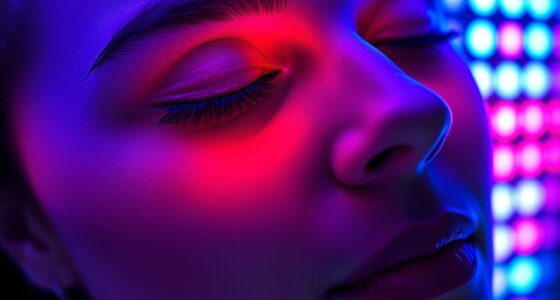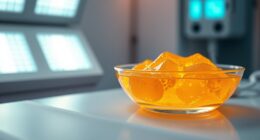To use LED therapy safely on rosacea-prone skin, choose gentle devices emitting red or near-infrared light designed for sensitive skin. Start with short sessions of about 10 minutes, gradually increasing as tolerated, and always follow manufacturer instructions. Use treatments every other day or a few times weekly, monitoring your skin for irritation. Incorporate soothing moisturizers afterward and avoid known triggers. If you’re curious about detailed steps to optimize results, keep exploring for more helpful guidance.
Key Takeaways
- Use LED devices emitting red or near-infrared light designed for sensitive skin and follow manufacturer instructions carefully.
- Start with short sessions (~10 minutes), gradually increasing duration based on skin tolerance.
- Schedule treatments every other day or a few times weekly, monitoring skin reactions closely.
- Apply soothing, fragrance-free moisturizers post-treatment and avoid known rosacea triggers.
- Consult a dermatologist for personalized guidance and be patient for visible improvements over several weeks.

If you have rosacea-prone skin, you might wonder whether LED therapy is a safe and effective treatment option. The good news is that, when approached carefully, LED therapy can be gentle and beneficial for calming redness and reducing inflammation. Unlike some aggressive skin treatments, LED devices are non-invasive, and the light used doesn’t heat or irritate your skin when used properly. However, because rosacea skin tends to be sensitive, it’s essential to follow a gentle protocol to avoid worsening symptoms or causing discomfort.
First, choose an LED device specifically designed for facial use and suitable for sensitive skin. Look for options that emit red or near-infrared light, as these wavelengths are known to promote healing, boost circulation, and reduce redness. Before starting any treatment, clean your face thoroughly and avoid applying heavy creams or products that might irritate your skin. Always read the device instructions carefully and start with the shortest session time recommended for sensitive skin—usually around 10 minutes. It’s better to begin slowly and gradually increase duration as your skin tolerates it.
Consistency is key when using LED therapy for rosacea. You might find that sessions every other day or a few times a week provide the best results without overwhelming your skin. Pay close attention to how your skin reacts after each session. If you notice increased redness, dryness, or irritation, reduce the frequency or duration of treatments. It’s also wise to perform a patch test on a small area of skin before applying the device to your entire face. This step helps you gauge your skin’s response and minimize the risk of adverse reactions.
Because rosacea can fluctuate, it’s important to supplement LED therapy with other gentle skincare practices. Use a fragrance-free, soothing moisturizer and avoid known triggers like spicy foods, hot beverages, or extreme weather. Additionally, recognizing that LED therapy is part of a broader impact of natural language processing (NLP) in understanding customer needs, personalized skincare recommendations can be provided through digital tools and apps. If you’re unsure about combining treatments or have particularly severe symptoms, consult a dermatologist beforehand. They can recommend a tailored approach, possibly integrating LED therapy with other therapies or medications that suit your skin’s needs.
Finally, remember that patience is essential. It might take several weeks of consistent, gentle use before you notice improvements in redness and irritation. Keep your sessions moderate and avoid overdoing it—your skin’s sensitivity requires a cautious approach. With proper guidance and gentle handling, LED therapy can be a safe, soothing addition to your rosacea management routine, helping you achieve calmer, healthier skin over time.
Frequently Asked Questions
Can LED Therapy Cause Any Long-Term Skin Damage?
LED therapy generally doesn’t cause long-term skin damage when used properly. You might experience temporary redness or irritation, but these effects usually fade quickly. If you follow a gentle protocol and consult with a professional, you reduce risks. Avoid overuse or excessive exposure, as that could potentially lead to skin sensitivity. Overall, LED therapy is considered safe and effective for rosacea-prone skin when done correctly.
How Often Should Rosacea-Prone Skin Undergo LED Treatments?
You should typically undergo LED treatments 2 to 3 times a week for rosacea-prone skin. While it may sound excessive, the gentle protocol is designed to prevent irritation and promote healing. Don’t overdo it, or you’ll risk aggravating your skin instead of soothing it. Consistency is key, but patience wins the race. Follow your dermatologist’s advice, and enjoy the calming benefits without risking setbacks.
Are There Specific LED Wavelengths Best Suited for Rosacea?
Yes, specific LED wavelengths work best for rosacea. You should look for treatments using blue light (around 415nm) to target bacteria and reduce inflammation, and red light (around 630-700nm) to soothe skin, promote healing, and decrease redness. These wavelengths penetrate the skin at different depths, helping calm rosacea symptoms effectively. Always consult with a skincare professional to customize the treatment for your skin’s unique needs.
Can LED Therapy Be Combined With Topical Rosacea Treatments?
Yes, you can combine LED therapy with topical rosacea treatments. It often enhances overall results by reducing inflammation and soothing skin. Make sure to consult your dermatologist first to guarantee compatibility and proper timing. Typically, you’d apply topical treatments after LED sessions or as advised, avoiding irritation. This combined approach can help you achieve calmer, clearer skin while minimizing potential side effects.
Is LED Treatment Safe for Sensitive, Rosacea-Prone Skin Types?
Oh, absolutely, LED therapy is practically your skin’s new best friend—if your skin’s delicate enough to host a tiny, glowing party. It’s generally safe for sensitive, rosacea-prone skin, especially when you choose the gentle protocols designed just for you. Just keep in mind, a cautious approach and consultation with your dermatologist are wise; after all, even the most luminous treatments need a gentle touch.
Conclusion
Remember, gentle LED therapy is like a soothing sunrise after a storm—bringing calm and renewal to your rosacea-prone skin. With patience and care, you hold the power to restore your skin’s natural glow, much like a dawn breaking through darkness. Trust in this gentle light to guide you toward balance and confidence. Embrace the process, and let each session be a step closer to the serenity you deserve. Your skin’s peaceful future starts now.
